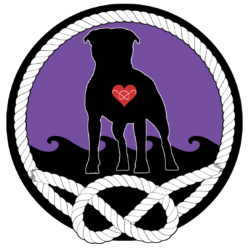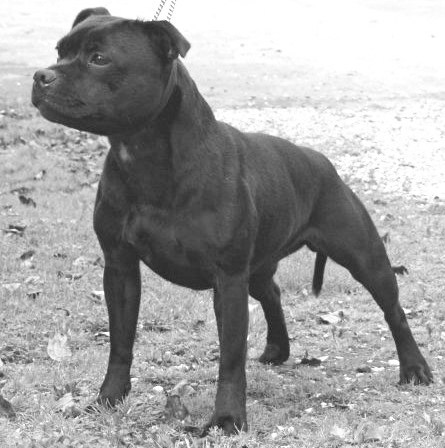
 Size, Proportion & Substance
Size, Proportion & Substance
“ Height at shoulder: 14 to 16 inches. Weight: Dogs, 28 to 38 pounds; bitches, 24 to 34 pounds, these heights being related to weights. Non-conformity with these limits is a fault. In proportion, the length of back, from withers to tail set, is equal to the distance from withers to ground.”
This portion of the Breed Standard seems to be a sticking point, or a dividing point for many Stafford breeders and enthusiasts for some reason. We just don’t understand what is so difficult to ‘get’ about it though. The wording is quite clear for our vaguely written Standard. There is nothing less clear than – HEIGHT AT SHOULDER: 14” TO 16”. It doesn’t say ‘preferred’ or ‘close to’ or ‘try as hard as you can to achieve’ this height. It simply means what it says – A Staffordshire Bull Terrier, to be in Standard height, must fall between 14” and 16” at the shoulder. Period.
The next sentence is equally clear. A Staffordshire Bull Terrier DOG in order to be in Standard weight must fall between 28-38 lbs. and BITCHES falling between 24-34 lbs. Period.
Now comes the vague part – for some, not for us: “These heights being RELATED to weights.” Easy peasy. How is this difficult? How is this controversial? It then goes on to clarify even further for judging and breeding purposes to state, “Non-conformity with these limits is a fault.”
This doesn’t mean that a Stafford dog can be 14” and 38 lbs. any more than it means a Stafford dog can be 16” and 28 lbs. That wouldn’t be in RELATION to one another would it? It all goes back to BALANCE.
Some people will go to extreme lengths to justify what is at the end of their lead by twisting these simple statements to make their dog fall into the category somehow – even if he clearly does not! In fact, we have also heard that it is IMPOSSIBLE to have a modern day Stafford fall within these height & weight limits. We have heard all sorts of absurd excuses such as:
•Dog food is so much better today than when the Standard was written so its ok for them to weigh more. NOT TRUE! Many years before ‘kibble’ diets were introduced dogs were fed whatever scraps and meats their owners could spare. The diet consisted of a much healthier variety, natural proteins and fats – not the mass produced garbage of today.
•Those weights were written as fighting dog weights. NOT TRUE! Dogs were fought in weight classes, therefore there were many acceptable weights for fighting dogs. A 28lb dog would never compete with a 38lb dog. The height to weight ratio in our breed standard had nothing to do with fighting. In fact the height was brought down from 18” down to 26” to accommodate the heavier dogs of the day.
•A Stafford would have to be starved and tread milled 7 days a week to meet those proportions. NOT TRUE! I can’t even believe this one except for the fact I heard it with my own ears at a Stafford judging seminar. How absurd. We have owned Staffords of several varieties – fitting the Standard to a “T” (16” tall and 38lbs – dog), too heavy (15.5” tall and 37lbs – bitch), too fine (15.75” tall and 32lbs – bitch). None of them were starved nor milled 7 days a week – all were kept fit by a variety of methods. It was their basic structure, genetics and breeding that either they conformed or not – not starving or over exercising. I was insulted when I heard this and appalled it was said to new judges.
•A Stafford with substance and bone can’t weigh that little. NOT TRUE! Yet another absurdity – breed for the Standard, dont change the Standard to fit your breeding!
•They need to weigh more in order to win. NOT TRUE!
(OK maybe so since extra weight can hide faults and if your exhibit has a dippy topline, no rib spring or a weak rear perhaps an extra 5 lbs. does hide these faults. What’s the point? Who are you trying to fool? It will be your fault when your breeding program is producing heavy, unbalanced and disproportional animals, won’t it? You can’t fool genetics.)
Moving onward to the next sentence: IN PROPORTION the length of back, from withers to tail set, is equal to the distance from withers to ground. SQUARE! Not squatty. Not short legged. Not long backed. When you draw a line from the withers to the tailset this line should be the same length as when you draw a line from the withers to the ground.
Lately we are seeing too many Staffords with short upper arms, or short in leg all over. Some are over angulated in the rear, and most are carrying an extra 4-8 lbs. Some even more. This can affect the health of the dog in many ways and should be avoided. Some have massive bone like the English Bulldog. In fact, we have seen a few that you have to look twice to see if there is a tail to determine if it is indeed a Stafford and not a Bulldog. Staffords should have leg under them in order not to be squatty, low riders. Remember – this is a SQUARE athletic breed. They need this in order to remain agile.
So if all goes according to plan and Mother Nature cooperates with you then when you breed for the Breed Standard you want a balanced, clean, square animal falling within these numbers and shapes. There’s really no reason they can’t. None at all – that is unless you are still making excuses for what you have and are doing to the breed.
Exaggeration exists on both ends. Neither is a goal if you plan to stay within the blueprint of the breed, the Standard. We have here several examples of Staffords fitting within the Standard. “Captain” at 3.5 years old stood a hair below 16” and weighed a hair above 37 lbs. He is the same length when measured from withers to tailset and from withers to the ground. He had plenty of bone, substance, leg – and he had a closely coupled body. We fed him approximately one pound of food per day and he was exercised at a minimum because of living in the hot Southern United States. He either swam or chased a ball in the early mornings or late evenings. His muscles were long and lean, not bunched. You could see his last rib at his waist but he was not a thin animal, nor was he a small Stafford. He was at the TOP side of the Staffordshire Bull Terrier Standard.
So, therefore, it IS possible to meet the Standard without going to any extremes at all.
You simply have to breed for it.


